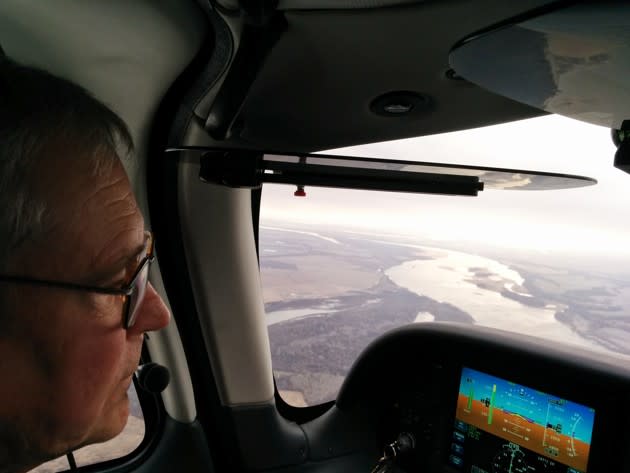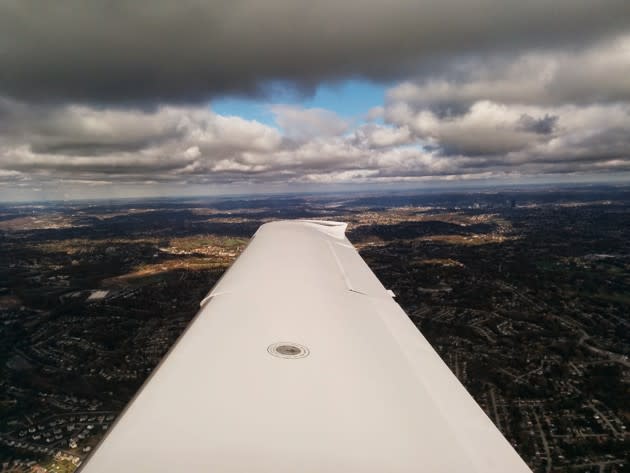View From the Right Seat
During our more than 50,000 miles of flight for our American Futures project, I’ve sat in the “right seat” of our Cirrus SR22. That’s the official term for my spot in the plane, and the right seat like the left carries all the fixtures for a full-fledged pilot: I am equipped with the steering, radio call button, and visual access to all the monitors to fly. I’m not a pilot (a story for another day), but I love being in the right seat.
By now, I am familiar with all the rhythms and quirks of the plane. I know and see the steps to acceleration and take-off. I know how the plane engine sounds as we press for speed and altitude. I can anticipate the degree of bumpiness to expect when we fly into big puffy clouds or little thin ones. I recognize the feel of the steep banking to enter the pattern to land and see the shifting colors of the lights on the field signaling the safe altitude for touchdown.
Recommended: Personal Stories of Abortion Made Public
It is very comforting to know every feel and sound so well, and it is also useful. I could identify the whistling sound when we failed to slam the cockpit door hard enough; it’s not really dangerous to fly with the door just shy of closed, because it’s not going to fly open with all that wind racing across it. I noticed an unusual airy sound when a small protective access plate under one wing had bent and eventually blew off. I know not to be alarmed when we catch sudden drafts, bouncing the plane as we fly over very hot deserts or high hills.

I know enough about the screen monitors to study the interesting details, like the altitude, the outside air temperature, the speed, wind direction and velocity, our heading, and miles to destination. I’m always rooting for tailwinds and disappointed when we encounter headwinds going both directions of a trip. That seems to happen more frequently than odds would dictate. But it is thrilling to catch a really strong tailwind, watch the speed increase, and hope for a personal-best record. We normally aim for about 170 knots, about 200 mph, but we have gotten as high as about 220 knots flying east over Iowa, carried by a really strong tailwind. It felt almost like hydroplaning.
We have our choice of what to listen to through our headsets: the air traffic controllers (ATC) are obligatory when they’re directing us on an instrument flight plan (IFR); they are optional company for us when we’re flying in visual flight conditions (VFR). In busier airspace, even if we don’t need the ATC, we’ll opt for “flight following,” which means that they keep an eye on us and occasionally speak with us if other planes come near. I sometimes do the ATC calls.
Recommended: 'Game of Thrones' Finally Became a Different Show in Season Six
We can also listen to Sirius/XM radio. Listening to farm reports over Kansas or truckers’ radio as we fly over I-80 add to the sense of place we feel flying over the land that drowns out the colorless CNN or Fox news. As Jim has described, the controllers are unfailingly unflappable. Mostly, the exchanges are routine and follow strict, scripted language designed for clarity and efficiency. You hear some variations: accents shift to a slow southern drawl as we fly down the east coast. On holidays, some controllers offer greetings. You catch hints of their exasperation when lazy pilots don’t listen well or fail to respond to frequent calls to their tail number. On the other hand, you hear patience behind controllers’ calls when they’re dealing with student pilots.

A few times, our exchanges with ATC have been memorable. Once we were caught over upstate New York in unexpected severe weather. The ATC took us as far as he could before handing us over to the next one. While navigating us around storms, he had asked for the number of “souls on board,” which I learned afterwards was the vernacular for “people on board,” but hearing the phrase for the first time was completely unnerving for me. Just before hand-off, he wished us good luck. That was kind, but also scary to me. Once we had a failed spark plug, and two separate times a failed alternator while in flight. For the latter, which is serious, the ATC inquired if we were declaring an emergency, which would signal a different set of actions, essentially giving us precedence over all the other planes in the area. (We weren’t.)
***
Read more from The Atlantic:
Why America's Business Majors Are in Desperate Need of a Liberal-Arts Education
Why the Supreme Court Is Making Christian Pharmacists Stock Plan B
This article was originally published on The Atlantic.
